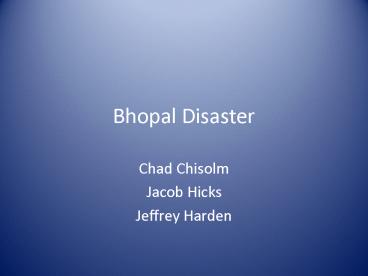Bhopal Disaster - PowerPoint PPT Presentation
1 / 15
Title:
Bhopal Disaster
Description:
Over 3,000 people died immediately. Approximately 8,000 ... Odor resembles freshly cut grass. Effects. Can be detected at 0.4ppm. Symptoms are slow to appear ... – PowerPoint PPT presentation
Number of Views:824
Avg rating:3.0/5.0
Title: Bhopal Disaster
1
Bhopal Disaster
- Chad Chisolm
- Jacob Hicks
- Jeffrey Harden
2
Overview
- This was an industrial disaster
- Occurred in Bhopal, India
- Over 3,000 people died immediately
- Approximately 8,000 died within two weeks
- Over 520,000 where exposed to the toxic gases
3
Overview
- The company was Union Carbide
- The disaster occurred December 4, 1984
4
(No Transcript)
5
Factors Leading to Mega-gas Leak
- The use of hazardous chemicals (MIC) instead of
less dangerous ones - Storing these chemicals in large tanks instead of
several smaller ones - Possible corroding material in pipelines
- Poor maintenance after the plant ceased
production in the early 1980's - Failure of several safety systems (due to poor
maintenance and regulations)
6
Disaster
7
Chemicals Present
- Phosgene
- World War 1 chemical weapon
- Methyl Isocyanate (MIC)
- Mono methylamines
- CO
- HCI
- NO
- Hydrogen cyanide
8
MIC
- Chemical
- Effects
- Very toxic
- Threshold of 0.02ppm
- Low level
- Causes coughing, chest pain, asthma, skin damage
- High level
- Lung edema, emphysema, hemorrhage, and death
- Chemical reaction
9
MIC Chemical Reactions
10
Phosgene
- Chemical compound (COCl2)
- It is a colorless gas used in World War 1
- Odor resembles freshly cut grass
- Effects
- Can be detected at 0.4ppm
- Symptoms are slow to appear
- Suffocation by causing alveoli damage
11
Phosgene
- CO Cl2 ? COCl2 ?Hrxn
- Phosgene reacts with water to release
hydrochloric acid and carbon dioxide - COCl2 H2O ? CO2 2 HCl
12
Hydrogen Cyanide
- Chemical Compound HCN
- Chemical agent that causes poisoning
- Listed under Schedule 3 substances of the
Chemical Weapons Conventions - Effects
- Prevents cellular respiration (can kill a human
in a few minutes)
13
Hydrogen Cyanide
- Hydrogen cyanide can be formed from virtually any
combination of hydrogen, carbon, and nitrogen - 2CH4 2NH3 3O2 ? 2HCN 6H2O
14
- 6. GREEN CHEMISTRY AND ECONOMICS
- Example Production of carbaryl
- 1) The way Union Carbyde used to make carbaryl
(in India) - Methyl isocyanate alpha-naphtol ? carbaryl
- Economics
- Methyl-isocyanate (57 grams/mole ) purchased at
2.50/kg and - Alpha-naphtol (144 grams/mole) purchased at
3.99/kg - Carbaryl (201 grams/mole) sold at 5.81/kg
- Profit per kg of carbaryl 5.81 - 2.50 x 0.057
x 4.98 - 3.99 x 0.144 x 4.98 - 5.81 - 0.71 - 2.86
- 2.24
- 2) The optimum solution from an environmental
perspective - Methyl formamide alpha-naphtol ? carbaryl
hydrogen - Economics
- Methyl formamide (59 grams/mole) purchased at
1.54/kg - Alpha-naphtol (144 grams/mole) purchased at
3.99/kg - Hydrogen (2 grams/mole) sold at 0.10/kg
- Carbaryl (201 grams/mole) sold at 5.81/kg
15
References
- http//www.epa.gov/ttn/atw/hlthef/methylis.html
- http//www.nationmaster.com/encyclopedia/Methyl-is
ocyanate - http//www.bhopal.org/whathappened.html
- http//www.absoluteastronomy.com/topics/Bhopal_dis
aster - http//www.hinduonnet.com/fline/fl2204/stories/200
50225005312500.htm - http//books.google.com/books?id8zQ0okoiCpkCpgP
A60lpgPA60dqMethylisocyanateHydrogenCyanide
sourceblotsSacFpk2dtRsigbf6YM6BHmsjXgqujVfq_
wq7SnYAhlensaXoibook_resultresnum1ctresu
ltPPA60,M1 - http//www.bt.cdc.gov/agent/phosgene/basics/facts.
asp































